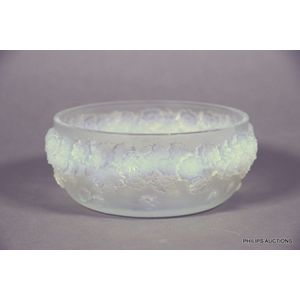Rene Lalique 'Primeveres' Opalescent Glass Bowl
You must be a subscriber, and be logged in to view price and dealer details.
Subscribe Now to view actual auction price for this item
When you subscribe, you have the option of setting the currency in which to display prices to $Au, $US, $NZ or Stg.
- Opalescent / Opaline - The descriptions of glass as "opalescent" or "opaline" are often used interchangeably by dealers and auction houses. At the upper end of the scale, opalescent / opaline glass can refer to the opal-like milky blue glass produced by Lalique and Etling. It also refers to the pressed glass mass produced in Britain from the 1840s with a milky white edge as sugar-basins, milk jugs and vases were made in great quantities for the mass market, and were sold at fairs along with Staffordshire figures and wooden dolls. A less common type of opalescent glass was made from two layers of glass blown into a mould.
- Frieze - An architectural term denoting the flat, shaped or convex horizontal surface of furniture, between the architrave and the cornice, usually found on a cabinet or bookcase, or on desks and tables where it may include drawers, the area between the top and the legs. In ceramics, the term refers to the banding, of usually a repeating pattern, on the rims of plates and vases.
- Etched - Glass decorated with an etched design, which is achieved through marking out the pattern, protecting the area that is not be etched, and then immersing the object in acid to dissolve the surface of the unprotected area. With some glass objects, such as cameo glass, there may be several layers of different coloured glass, and part of the top layer is dissolved leaving the bottom layer as the background. The longer the time of exposure of the object to acid, the deeper the etching.
The word etching is also sometimes used to describe another method of decoration, where wheel grinders were used decorate the surface, but this technique is usually known as engraving.
This item has been included into following indexes:
-
Lalique (France), item types
- boxes 56
- small bowls 338
Visually similar items

Venini 'sommerso a Bollicine' Murano glass bowl with gold leaf inclusions designed by Carlo Scarpa, two line acid stamp 'Venini Murano', circa 1935. 6.5 cm diameter

A rare Tibetan rock crystal 'Kapala? (skull cup), 18th century

A 'shufu'-type bowl, 13/14th century, the steeply rounded sides decorated in relief on the interior with flowering sprays within a key-fret band below the barbed and flared rim, covered with a slightly opaque bluish glaze falling short of the foot, 14.5 cm

Shoji Hamada (Japanese 1894-1978) oversized tea bowl, 11.5 cm dia, 11 cm height PROV: In 1965, Hamada brought with him a major exhibition which was shown at the Canterbury Museum. The vendor's mother was the photographer at the exhibition and purchased thi
